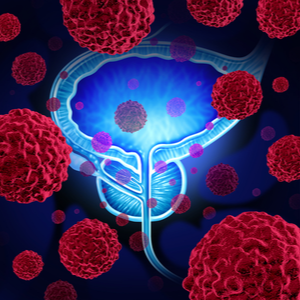
Prostate cancer: typical symptoms, early detection and treatment options
Prostate cancer affects the prostate gland, the so-called prostate carcinoma, and occurs particularly frequently in older patients. Last but not least, prostate cancer is considered one of the most malignant tumours in men, prone to metastases, and is among the third most common cause of cancer-related deaths. However, prostate cancer is also considered to have a good chance of being cured. Provided, of course, that the cancer is diagnosed and treated early enough, for example, in the course of a preventive medical check-up.
Development of prostate cancer and typical symptoms
Statistically, prostate cancer affects 6 percent of all men over 70. In 40-year-olds, on the other hand, the risk is only 0.1 percent. In addition to the risk factor of age, hormonal factors such as male sex hormones and genetic predisposition also play a role. Furthermore, there may be an as yet insufficiently scientific proof between benign prostate enlargement, so-called benign prostatic hyperplasia, and certain symptoms such as pain when urinating (micturition disorder) and/or the urge to urinate at night. However, it should be explicitly pointed out at this point that especially in the early stages of prostate cancer, there are no typical symptoms, because the tumour usually grows slowly and therefore does not cause prostate pain. The tumour growth is initially limited to the prostate (localised prostate carcinoma) and gradually grows into the neighbouring tissue of the prostate (locally advanced prostate carcinoma). Even with locally advanced prostate cancer, however, there are still symptoms that are not necessarily related to cancer. These symptoms include:
- frequent urination
- Urinary discomfort, such as burning, which can also be a sign of urinary tract infection
- Blood in the urine, which can also be caused by kidney or ureteral stones
- Blood in the semen, which can also be a sign of prostatitis
- erectile dysfunction, which is often mistaken for impotence
Only after the cancer has spread (so-called advanced metastatic prostate cancer) can patients complain of other symptoms. Since metastases often form in the bones, especially in the spine, they cause severe pain there. In addition, there may be other non-specific symptoms such as tiredness, fatigue, poor performance and/or general weakness.
Diagnosing and treating prostate cancer at an early stage
The same applies to prostate cancer: the earlier the diagnosis is made, the better the chances of cure. If prostate cancer is diagnosed at an early stage, it can be cured. However, if the tumour has already spread and developed metastases in the bones, for example, life expectancy is significantly lower. Since prostate cancer does not cause any typical symptoms, men over the age of 45 should undergo regular prostate examinations. In Germany, this can be done free of charge as part of the statutory insurance cover. The external genital organs and the prostate are palpated through the rectum. In addition, the so-called PSA value is determined. This is the prostate-specific antigen protein that is produced by the prostate gland. If this value is elevated, the probability of prostate cancer also increases, although the PSA value is also dependent on a variety of influences.
If prostate cancer is suspected, tissue samples are taken from the prostate (so-called prostate biopsy). Depending on how the prostate cancer is to be treated, further diagnostic examinations, such as sectional imaging by an MRI or a CT, may be used in individual cases. Depending on the aggressiveness of the tumour and the life expectancy of the patient, the following treatment options may be considered:
- long-term observation, or active surveillance (mainly used at an early stage)
- Surgery (at an advanced stage)
- Radiation (at an advanced stage)
- Hormone therapy or chemotherapy (in the advanced stage)
Living with a prostate cancer diagnosis
Especially after prostate surgery or radiotherapy, most patients need several months to fully recover. Especially within the first 4 to 6 weeks, those affected should avoid physical exertion and actively support the healing process through rehabilitation measures.
Frequencies of prostate cancer
|
Pathogen |
Source |
Comment |
Frequencies |
|
Prostate tumour |
Members get access to the frequencies immediately after registration. |
||
|
EDTFL |
Members get access to the frequencies immediately after registration. |
||
|
KHZ |
Also use Blood Purification |
Members get access to the frequencies immediately after signing up. |
|
|
PROV |
Also use blood purification |
Members get access to the frequencies immediately after registration. |
|
|
Use also blood purification |
Members get access to the frequencies immediately after registration. |
||
|
XTRA |
Also use blood purification |
Members get access to the frequencies immediately after registration. |
|
|
XTRA |
Also use blood purification |
Members get access to the frequencies immediately after registration. |
|
|
XTRA |
Also use blood purification |
Members get access to the frequencies immediately after registration. |
|
|
Prostate Adenominum |
PROV |
Homeopathic Frequencies for Prostate Tumours |
Members get access to the frequencies immediately after registration. |
